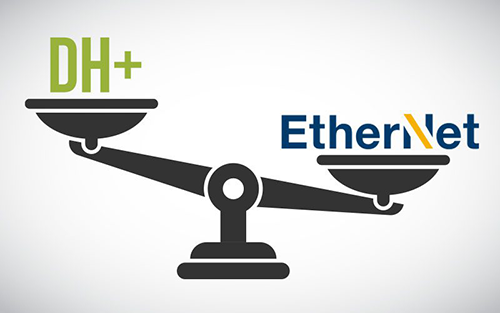- By John S. Rinaldi
- May 16, 2023
- Real Time Automation, Inc.
- Feature
- Sponsored
Summary
Because DH+ is many years older than Ethernet, it's not not nearly as fast, sophisticated or flexible. However, it supported the manufacturing applications of its time very well.

When it comes to industrial communications protocols, one of the inevitable questions is: How does it compare to Ethernet? It’s a fair question, and, because it requires an answer, here’s my take on it.
Baud rate
Ethernet is exceptionally fast and gets faster every day. 1GB and 10GB are currently supported with 100GB on the horizon. DH+ supports a set of much lower baud rates; 57.6, 115.2K and 230.4K baud. Unlike Ethernet, there are no switches allowing devices with slower baud rates to participate in the network. All DH+ devices must use the same baud rate.
Cabling
CAT5 and CAT6 cabling are typical cables for Ethernet systems. CAT5 consists of four twisted pairs of copper wire. It’s probably the cabling you used at the office before you started using wireless connections. CAT5E and CAT6 are enhanced cabling types that provide higher bandwidth and up to 10Ghz speed. DH+ uses very simple cabling with one twisted pair surrounded by a shield.
Cable length
CAT5 is typically rated for less than 400 feet, far less than the 10,000 feet of trunk cable supported by DH+. This is the one area where DH+ has an advantage over Ethernet though Ethernet backbones render that benefit superficial.
Supported controllers
DH+ supports all the original Allen-Bradley PLCs, the PLC2 and the PLC3. Some controllers in the PLC5 line supported DH+, others support Ethernet while still others support both.
Number of devices
DH+ networks are limited to 64 devices while Ethernet networks are virtually unlimited.
Device addressing
Ethernet uses the standard dot decimal addressing while a station number between 0 and 63 is used to address a DH+ device. It is illegal to have duplicate station numbers on either network.
Cost
With a limited number of possible customers, DH+ was a pricey solution in its day and, at first, only used by the biggest of Allen-Bradley customers. Ethernet, on the other hand, is a mass consumer product used by millions and it is inexpensive because of the commercial volume.
Network architecture
The network architecture for Ethernet is much more sophisticated than the network architecture for DH+. Ethernet uses a layered approach to communication using a physical layer, a data link layer, a network layer and an application layer. DH+ use few layers (physical layer, link layer and application layer) and the DH+ layers are much less sophisticated than Ethernet layers.
Network communications
Ethernet and its switch infrastructure allow maximum network throughput with many devices being able to send messages simultaneously. DH+ is more like the original version of Ethernet where only one device can talk while the rest listen.
Network mastership
Ethernet itself does not use the concept of a network master though some Ethernet application layer protocols do. With Ethernet, any device can send messages to any other device at any time. In DH+, there is a strict protocol where only the device holding the token can send messages. Devices receiving messages hold their response until the token rotates to them, at which point they issue the response to the message previously received.
Because DH+ is many years older than Ethernet, it's not not nearly as fast, sophisticated or flexible. However, it supported the manufacturing applications of its time very well.
About The Author
John Rinaldi is Chief Strategist, Business Development Manager and CEO of Real Time Automation (RTA). After escaping from Marquette University with a degree in Electrical Engineering, John worked in various jobs in the Automation Industry before once again fleeing back into the comfortable halls of academia. At the University of Connecticut, he once again talked his way into a degree, this time in Computer Science (MS CS). John is a recognized expert in industrial networks and the author of five books: The Smart Product Manager’s Guide to Industrial Automation Connectivity; Modbus: The Everyman’s Guide to Modbus; OPC UA - Unified Architecture: The Everyman's Guide to OPC UA; and his latest, The Everyman’s Guide to Properly Architecting EtherNet/IP Networks.
Did you enjoy this great article?
Check out our free e-newsletters to read more great articles..
Subscribe